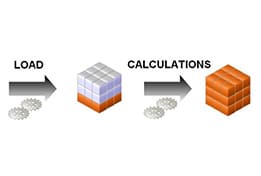Using Essbase in Large Scale Data Warehousing

While well-suited to managing transactions and storing large amounts of data, relational databases are typically unable to handle ad hoc, speed-of-thought analytical querying for large scale usage. Online analytical processing (OLAP) technology provides the scalability, performance, read/write and analytic capabilities necessary to support these tasks; thus; a combination of a two tiered model (hub-and-spoke); made up of both relational and OLAP technologies with a centralised data warehouse (such as Hyperion Essbase) are used to maximise benefits.
Hyperion Essbase is an OLAP multi-dimensional database server that extracts data from a wide range of sources; calculates and aggregates this data; providing speed-of-thought results. It’s ability to handle large numbers of users in an ad hoc environment proves that the Hyperion Essbase solution is suitable for large-scale, web-enabled data warehousing.
Top Reason for Failure:
- When companies focus on building large warehouses integrating multiple data sources rather than the demand for data and end-user requirements; such as interactive performance and rapid deployment.
- “Point-to-point” solutions: different data marts are built from different systems using different business rules; resulting in data inconsistencies depending on which data mart you export data from.
How the two-tiered OLAP model works:
- Data warehouse provides a central database for large amounts of varied data, and relational databases are deployed as the underlying database technology.
- Data marts deliver focused business user applications such as balanced scorecards, e-business analytics and performance management.
- Integrated/synchronised metadata is critical (Hyperion Integration Server); seamlessly linking data marts and the relational sources; ensuring consistent and up-to-date data; speeding up deployment, easing maintenance and enabling seamless navigation between the mart and the warehouse.
Importance of OLAP:
OLAP technology supports collaboration throughout the business management cycle of reporting, analysis, what-if modeling and planning. Additionally to this; OLAP technology can carry out Aggregation, Matrix calculations, |Cross-dimensional calculations, Procedural calculations and OLAP-aware calculations.
Benefits:
- Speed- of-thought response times: Fast performance allows users to interact and explore data in real time, increasing user adoption and allowing users to focus on optimising the business. Thus, companies using Hyperion Essbase are able to rapidly deploy data marts and adapt to changing business environments.
- Query Designer: Using the Essbase Query Designer; drill-down, pivot and “top-n” analytical queries can be carried out, with rapid response times enabling end-users to automatically drill down from calculated data to detail data stored in the relational database, designing and executing specific queries, without having to have a knowledge of SQL querying/IT assistance.
- Read/Write capabilities: Using a centralised database, companies can share information throughout the organisation securely. Additionally, end-users can update the database and analyse the impact of those updates; which is essential in planning and forecasting.
- Broad application support: Analytic applications built on Hyperion Essbase address a broad range of disciplines, including manufacturing analytics, demand management analytics, e-business analytics, ERP, CRM analytics, and human resource management (HRM) analytics.
- E-business analytic applications measure the effectiveness of on-line advertising and promotion activities, enhancing an organisations business through increased on-line sales and linking traditional operational systems with web systems.
- CRM analytic applications enable organisations to better understand who their most profitable and least profitable customers and products are, identify where cross-selling and up-selling opportunities exist and how to maximise promotional effectiveness; through the use of allocation calculations by spreading items such as revenues and expenses across departments, products, customers and projects.
- Demand management applications: analysing influencing demographic factors by tracking historical demand values, trend patterns in order to forecast future values and the impact of different possible internal and external changes.
- Business Performance analysis: enables end-users to analyse value-added business metrics; and opening and closing inventories with flexible up-to-date reporting tools; providing an accurate picture of business performance.
Hyperion Essbase empowers organisations to gain a competitive advantage, anticipate trends and capitalise on opportunities through the supply of unique insights into their market and customers. The integrated nature of the analytic applications allows companies to better understand and strategically manage their organisations, supporting the entire management cycle of reporting, analysis, modeling and planning. Strategic use of such in-depth information allows organisations to realise maximum return on their existing IT investments in terms of ERP systems, e-business, CRM systems, and data warehouses; adding value to previously inaccessible data and transforming it into actionable information.